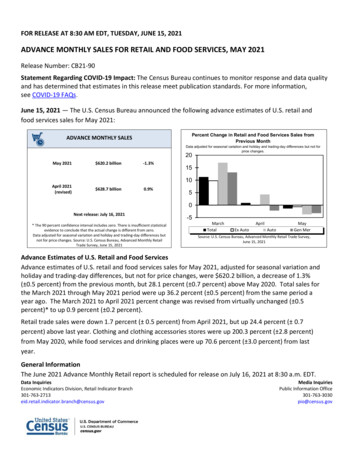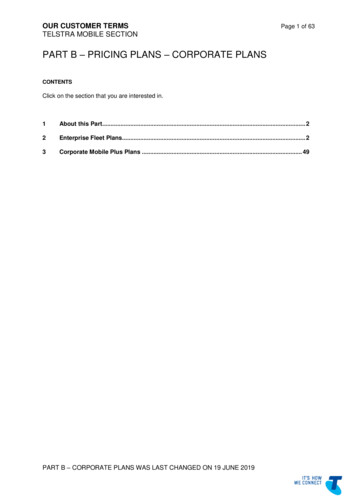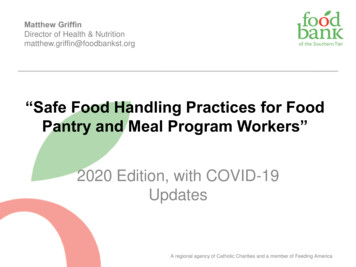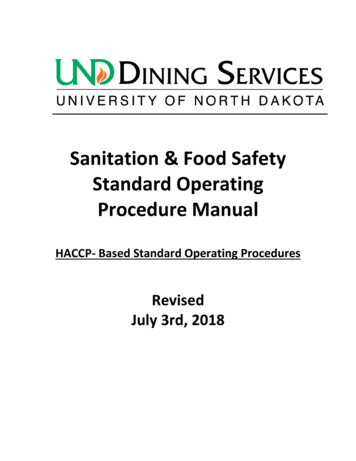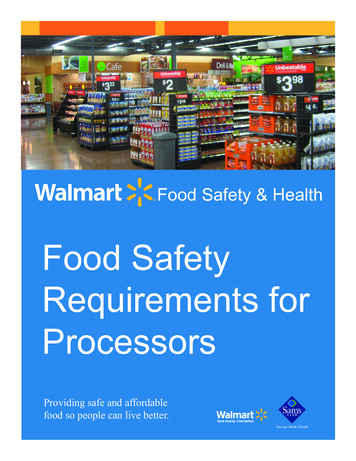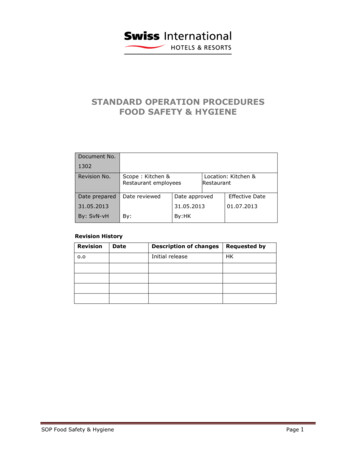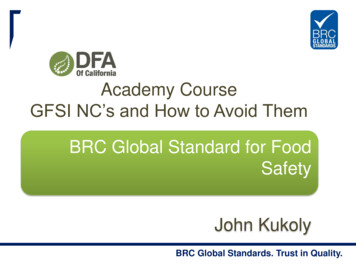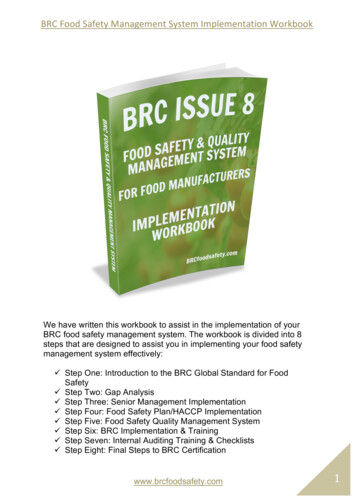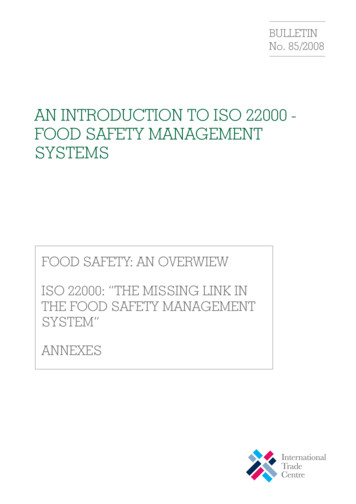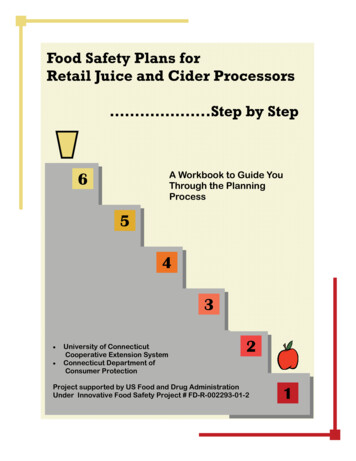
Transcription
Food Safety Plans forRetail Juice and Cider Processors .Step by StepA Workbook to Guide YouThrough the PlanningProcess6543University of ConnecticutCooperative Extension System Connecticut Department ofConsumer Protection 2Project supported by US Food and Drug AdministrationUnder Innovative Food Safety Project # FD-R-002293-01-21
Food Safety Plan for Retail Juice and Cider Processors .Step by StepTABLE OF CONTENTSINTRODUCTION3FOOD SAFETY HAZARDS IN JUICE AND CIDER7YOUR FOOD SAFETY PLAN14STEP 1: FOLLOW GOOD AGRICULTURAL PRACTICES15STEP 2: FOLLOW GOOD MANUFACTURING PRACTICES27STEP 3: DEVELOP AND FOLLOW A SANITATION PLAN31STEP 4: MONITOR KEY FOOD SAFETY FOCUS POINTS55STEP 5: DEVELOP A TRACEBACK SYSTEM65STEP 6: KEEP GOOD RECORDS71APPENDIX751. Good Manufacturing Practices, CFR 120, part 11067
2Food Safety Plan forRetail Juice and Cider Processors .Step by StepForwardThe Connecticut State Department of Consumer Protection and the University of ConnecticutCooperative Extension System have been working together to bring you the latest information abouthow to make sure that the cider and juice you produce is as safe as it can be.Retailers of juice are those who sell directly to the consumer at their own farm stand, a farmer’s marketor online. Retailers do not need to adopt a HACCP plan and have the option to treat or not to treat theircider to achieve the 5 log reduction of E. coli O157:H7 or cryptosporidium parvum. (Those who do notachieve a 5 log reduction, i.e., those who sell unpasteurized juice, must have a warning label on thebottle.)Does this mean that retailers do not have to follow rules and regulations to make their cider safer? No.Cider processors must still comply with certain federal, state and local rules and regulations. Keep inmind that an outbreak of foodborne illness attributed to a retail operation will have a negative impact onall of the cider industry, as well as devastating effects on the processor’s operation.To help retail processors of juice to produce safe cider, we have developed this workbook. Theworkbook takes the retailer step-by-step through the development of what we call a Food Safety Plan.While much simpler than a HACCP plan, a Food Safety Plan will help you to focus on the steps in youroperation that need special attention. It is likely that you are already using many food safety practicesin your operation. Formalizing these practices and writing them down as a Food Safety Plan willindicate to regulators and consumers alike that you are committed to producing a safe juice product.This workbook was developed by:Diane Wright Hirsch, MPH, RD; Extension Educator/Food SafetyUniversity of Connecticut Cooperative ExtensionandPeter Cisek, MS; Food Safety Program AssistantUniversity of Connecticut Cooperative Extensionwith assistance from:Frank Greene, RS, MPH; Director, Division of Food and StandardsConnecticut Department of Consumer ProtectionEllen Sloan; Food InspectorConnecticut Department of Consumer ProtectionIssued in furtherance of Cooperative Extension work, Acts of May 8 and June 30, 1940, in cooperation with the U.S.Department of Agriculture, Gregory Weidemann, Director, Cooperative Extension System, University of Connecticut, Storrs.An equal opportunity program provider and employer. To file a complaint of discrimination, write USDA, Director, Office ofCivil Rights, Room 326-W, Whitten Building, Stop code 9410, 1400 Independence Avenue, SW, Washington, DC 20250-9410or cal 202.720.5964.Food Safety Plan for Retail Juice and Cider Processors .Step by Step
3INTRODUCTIONFood safety is a concern for anyone in the food business. If the juice you produce makes a customersick, there will be health, legal, and economic consequences for you, your customers, and others in theindustry.While once considered an unlikely cause of foodborne illness, juice related outbreaks in the 1990salerted processors, regulators and consumers to the fact that fresh juice (especially if unpasteurized)needed a closer look. As a result of these outbreaks and the increased concern about the safety offresh juice products, the U.S. Food and Drug Administration (FDA) passed the Juice HACCP rule in2001. This rule requires all juice processors, other than those only selling retail from their farm stand orfarmers market, to implement a plan for Hazard Analysis Critical Control Point or “HACCP.”Retailers (juice processors that sell their juice only directly to the public—at a farm store, roadsidestand, farmer’s market or on the internet) are not required to develop a HACCP plans under federallaw, but that does not mean that they shouldn’t seriously consider writing a HACCP plan or at the least,adopt some type of food safety plan to help them focus on the safe handling of their product.Retail operations are usually regulated by state agencies applying state regulations often based uponFDA’s Model Food Code, a guidance document that describes appropriate controls that can beapplied to reduce juice hazards at the retail level. FDA does require that packaged juice productsproduced by retail establishments either undergo a treatment designed to ensure an effective 5-logpathogen reduction, (just as juice subject to the HACCP regulation must undergo) or bear a warninglabel that explains that the juice has not been treated to ensure its safety and that it may containharmful bacteria that can cause serious illness, especially in children, the elderly and persons withweakened immune systems. Juice not sold in packaged form, such as juice served by the glass atrestaurants and juice bars, is not subject to either the HACCP regulation or to the warning labelrequirement.Retail juice safety words to know: FDA’s Model Food Code is a guidance document used by states to develop food safetyregulations for retail food operations. You may find information about the Model FoodCode ilFoodProtection/FoodCode/default.htm. Juice Hazard Analysis and Critical Control Point (HAACP); Procedures for the Safeand Sanitary Processing and Importing of Juice is the US FDA regulation requiring aHACCP plan and implementation for processors of juice (except those who retail juiceonly). A copy may be found P/ucm2006803.htm. The 5-log reduction performance standard required by the HACCP regulation means thatyou must treat your juice (or citrus fruit if using surface treatments) using a process that willachieve at least a 100,000 fold decrease in the number of microorganisms. Juiceprocessors must apply controls (e.g., heat) to achieve the 5-log reduction required by theregulation.Because retailers do not need to comply with the FDA Juice HACCP rule, and because retailers are stillable by regulation to produce unpasteurized fresh juice, it could be argued that juice produced byretailers is more “risky.” If an outbreak should occur that is attributed to a retail producer, it could havea negative impact on all producers of fresh juice and cider.Food Safety Plan for Retail Juice and Cider Processors .Step by Step
4This workbook is one tool to use when putting together your food safety plan. It provides you with basicinformation about what you need to include in your plan; how to work through it; how to develop aprogram that meets the needs of your operation; and how to meet the needs of the regulators thatoversee your operation. After each step is described, there are activities or worksheets for you tocomplete. If you complete the activities or worksheets as you go along, you will have a food safety plandeveloped by the time you get to the end of the workbook.Your food safety planBecause juice and cider are produced from raw agricultural products, the safety of your final productwill depend on how the fruit and juice are handled from time the fruit is in the field or orchard to the timeit is purchased by the consumer, especially, if you do not plan to pasteurize your product or treat it withUV light. So, it is important to include the following components in your food safety plan:Step 1:Step 2:Step 3:Step 4:Step 5:Step 6:Follow Good Agricultural Practices (GAPs)Follow Good Manufacturing Practices (GMPs)Develop and Follow A Sanitation PlanMonitor Key Food Safety Focus PointsDevelop a Traceback PlanKeep Good RecordsFood Safety Plan for Retail Juice and Cider Processors .Step by Step
5Food Safety Hazards in Juice and CiderFood Safety Plan for Retail Juice and Cider Processors .Step by Step
6Food Safety Plan for Retail Juice and Cider Processors .Step by Step
7FOOD SAFETY HAZARDS IN JUICE AND CIDERHistory of Foodborne illness and Juice:Until recently, the fresh fruit and vegetable industries have been relatively untouched by the threat oftheir products causing foodborne illness. However, in the last 5-8 years there have been severalincidents that have involved fruits and vegetables that were up until now considered at low risk forcausing foodborne illness. Salmonella has been associated with cantaloupe, Escherichia coli O157: H7with lettuce, and cyclospora with raspberries.Fresh juice-related outbreaks have included cider/apple juice outbreaks occurring in Oklahoma (E. coliO157:H7) in 1999, California (E. coli O157:H7), Connecticut (E. coli O157:H7), and New York(Cryptosporidia) in 1996 and in Massachusetts (E. coli O157:H7) in 1991and New Jersey (Salmonella).In addition, orange juice outbreaks have occurred in 1992 (India), 1995 (Florida), 1999 (Australia andU.S.-made in Arizona), 2000 (California). Outbreaks have also been attributed to carrot juice,watermelon juice, mamey juice, lemonade and grapefruit juice. The primary organisms involved inthese outbreaks were Salmonella and E. coli O157:H7.Foodborne illnessFoodborne illness is caused primarily by microorganisms. Microorganisms that cause disease arefound naturally in the environment. Juice contaminated with pathogenic microorganisms usually doesnot look bad, taste bad, or smell bad. It is impossible to determine whether juice is contaminated withpathogenic (disease causing) microorganisms without microbiological testing. To avoid potentialproblems it is important to control or eliminate these microorganisms during processing.Spoilage vs. Contamination (not all microorganisms cause foodborne illness)It is important to remember that not all biological, physical, and chemical hazards willcause foodborne illness. Some of these hazards are going to spoil the quality of theproduct, but not affect the safety. They are not pathogenic or disease causing. Examplesinclude:·bacteria that cause slime formation·bacteria or yeasts that cause fermentation in fruit juices·a hair in canned juice (that has been thermally processed)Pathogenic microorganisms can be transmitted to humans by a number of routes, including air, water,direct person-to person contact and food. Some pathogenic microorganisms can be transmitted to foodby animals, or by contact with the soil, or by contact with contaminated surfaces and equipment.The severity of the foodborne illness depends on the pathogenic microorganism or toxin ingested, theamount of the microorganism or toxin consumed (dose), and the health status of the individual. Forindividuals who have immunocompromised health conditions (those being treated for cancer or HIV, orwho have had organ transplants), or for the aged, children, or pregnant women, foodborne illness maybe life-threatening.Food Safety Plan for Retail Juice and Cider Processors .Step by Step
8Three Types of Food Safety Hazards that affect apple ciderI. Biological Food Safety Hazards BacteriaBacteria are the number one cause of foodborne illness from juice. Foodborne disease causingbacteria cause illness when a consumer drinks juice/cider containing bacteria such as E. coliO157:H7 and the bacteria then grow and establish themselves in the human intestinal tract.Bacteria can be destroyed by heating (pasteurization) to a specific temperature for a specific lengthof time.Bacteria may be brought into your operation on employees, on raw fruit, on trucks, equipment orboxes used to transport food. The best defense is to assume that bacteria are always there and tocontrol the environment to prevent or minimize their growth and/or contamination.How Bacteria Grow in Juice:Bacteria do not survive and grow just anywhere---they need a favorable environment to thrive.Bacteria need moisture, a food source, enough time, and the right temperature and pH togrow and multiply.Moisture. Bacteria need water to grow. Moisture requirements are different for each speciesof bacteria. If water is not available in a food product, the bacteria may remain but will notgrow and multiply.Water Activity (Aw) describes the availability of water in food. Most bacteria cannot grow at awater activity of less than 0.91. Juices have an Aw of .97, providing plenty of moisture toallow for the growth of microorganisms.Food. Bacteria need a source of nutrients to grow and multiply. Carbohydrates provide themain source of energy. Fruit and vegetable juices are excellent sources of these nutrients.Potentially Hazardous FoodsPotentially hazardous foods (PHF) support the growth of bacteria and are the foods most commonlyassociated with foodborne illness. Typically they are high in moisture, low in acid (neutral or higherpH), and contain carbohydrates and protein.Potentially Hazardous Foods (PHF)Meat, fish, poultry, eggsDairy products including milk, cream, soft cheeses, ice cream, yogurt, sour creamCooked rice, macaroni, noodles, cerealsCooked potatoes, vegetablesCut cantaloupe and other melonsGarlic in oil mixturesSoy products such as tofu, misoRaw seed sproutsMost food regulations do not list fresh fruits and vegetables and juices as potentially hazardous foods(except for sprouts and melon). However, recent foodborne illness outbreaks tied to fresh fruits andvegetables and juices challenge our previous notion of what makes a food Potentially Ha
and Sanitary Processing and Importing of Juice HACCP plan only). A copy ma cm2006803.htm The you must treat your juice (or citrus fruit if using surface treatments) using a process th achieve at least a 100,000 fold decrease processors must apply controls (e.g., heat) to achieve the 5 regulation.File Size: 510KBPage Count: 88People also search forjuice haccp cfrjuice haccp examplejuice haccp guidancejuice haccp planjuice haccp regulationraw juice haccp
